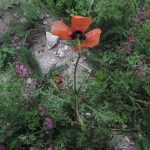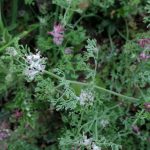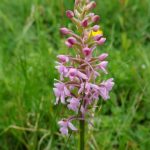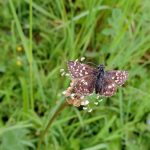On Saturday 11th June 18 RDNHS members led by Julia Cooper paid a return visit to the 1,000ha Cholderton Estate near Andover. The owner Henry Edmunds kindly spent the day taking us to parts of the organically managed estate which demonstrated his major objectives: to achieve sustainability, to protect the environment and conserve nature. Transport was also provided by his PA Adam Lowe and members Ken White and John Lerpiniere. First we went to the garden of Henry’s house, where an area is dedicated to preserving rare arable weeds such as Shepherd’s-needle (Scandix pecten-veneris), Field Gromwell (Lithospermum arvense), Weasel’s Snout (Misopates orontium) and Small Toadflax (Chaenorhinum minus). In his Arboretum, Henry preserves rare native trees and shrubs such as the true Service-tree (Sorbus domesticus), Wild Service-tree (S. torminalis), Arran Whitebeam (S. arranensis), Plymouth Pear (Pyrus cordata), Barberry (Berberis vulgaris) and Fly Honeysuckle (Lonicera xylosteum). In this area we also found a White Helleborine (Cephalanthera damasonium).
We were then transported to the Wiltshire part of the estate, where there is a Woodland Burial Site. Henry explained how he managed an adjacent field for Lapwings (Vanellus vanellus) – 2 pairs had raised chicks which had fledged recently. Here we saw two running hares (Lepis capensis) and a roe deer observing us. Another field sown with oats was coloured red because of the presence of many flowering Common Poppies (Papaver rhoeas). There were also many interesting other weeds, such as Henbit Dead-nettle (Lamium amplexicaule), Sun Spurge (Euphorbia helioscopia), Common Broomrape (Orobanche minor), Field Pansy (Viola arvensis), Field Madder (Sherardia arvensis), Wall Speedwell (Veronica arvensis), Rye Brome (Bromus secalinus) and Parsley-piert (Aphanes arvensis). The weeds do not make the oat crop less valuable, because the crop is used for animal feed on the farm. The advantage of these weeds for wildlife is that they supply nectar for bees and seeds for farm birds during all seasons and not just for a few weeks as is the case with rapeseed. Long-stalked Crane’s-bill (Geranium columbinum) was another nice find in this area. At another site a pair of Stone Curlews (Burhinus oedicnemus) was seen in the distance and a Grizzled Skipper (Pyrgus malvae) was also observed.
It had been raining slightly all morning, but after we had sat down for our lunch the drizzle fortunately stopped. We ate our sandwiches close to a true arable weed paradise which was coloured dark-red because of the presence of thousands of flowering fumitories. The main species was Dense-flowered Fumitory (Fumaria densiflora). Yellow spikes of Wild Mignonette (Reseda lutea) towered above them. Further inspection of the site revealed the rare white-flowered Fine-leaved Fumitory (Fumaria parviflora) as well as Narrow-fruited Corn-salad (Valerianella dentate), Musk Thistle (Carduus nutans), and four different species of poppy. Apart from the Common Poppy, there were Long-headed Poppy (Papaver dubium), Rough Poppy (P. hybridum) and Prickly Poppy (P. argemone), which could be distinguished not only by their fruits, but also by their flower colour. We were then shown restored chalk downland with a good selection of native chalk plants such as Dropwort (Filipendula vulgaris), Horseshoe Vetch (Hippocrepis comosa), Sainfoin (Onobrychis viciifolia), Common Milkwort (Polygala vulgaris), Mouse-ear-hawkweed (Pilosella officinarum), Wild Thyme (Thymus polytrichus), Cowslips in fruit (Primula veris), Salad Burnet (Poterium sanguisorba), Fragrant Orchid (Gymnadenia conopsea), Pyramidal Orchid (Anacamptis pyramidalis) and a leaf rosette of Woolly Thistle (Cirsium eriophorum). Lepidoptera included the butterflies Common Blue (Polyommatus icarus), Small Blue (Cupido minimus), Small Heath (Coenonympha pamphilus) and Painted Lady (Vanessa cardui) and the moths Five-spot Burnet (Zygaena trifolii) and Cistus Forester (Adscita geryon).
Transported back into Hampshire, we visited another superb chalk meadow with even more special plants, such as Common Rock-rose (Helianthemum nummularium), Quaking-grass (Briza media), Hoary Plantain (Plantago media), Hairy Violet (Viola hirta, leaves only), Common Spotted-orchid (Dactylorhiza fuchsii) and three clumps of the rare Meadow Clary (Salvia pratensis). A Wood Tiger moth (Parasemia plantaginis) was also observed. Henry showed us an area managed for Duke of Burgundy butterflies where he had seen four flying the previous day, but the overcast conditions today were not suitable for them. The final visit was to the south of the estate where three pairs of Corn Bunting were nesting. Back at the farmyard we thanked Henry and Adam for the magnificent tour.
Report by Renée Grayer
Pictures by Rob Stallard and Laurie Haseler






